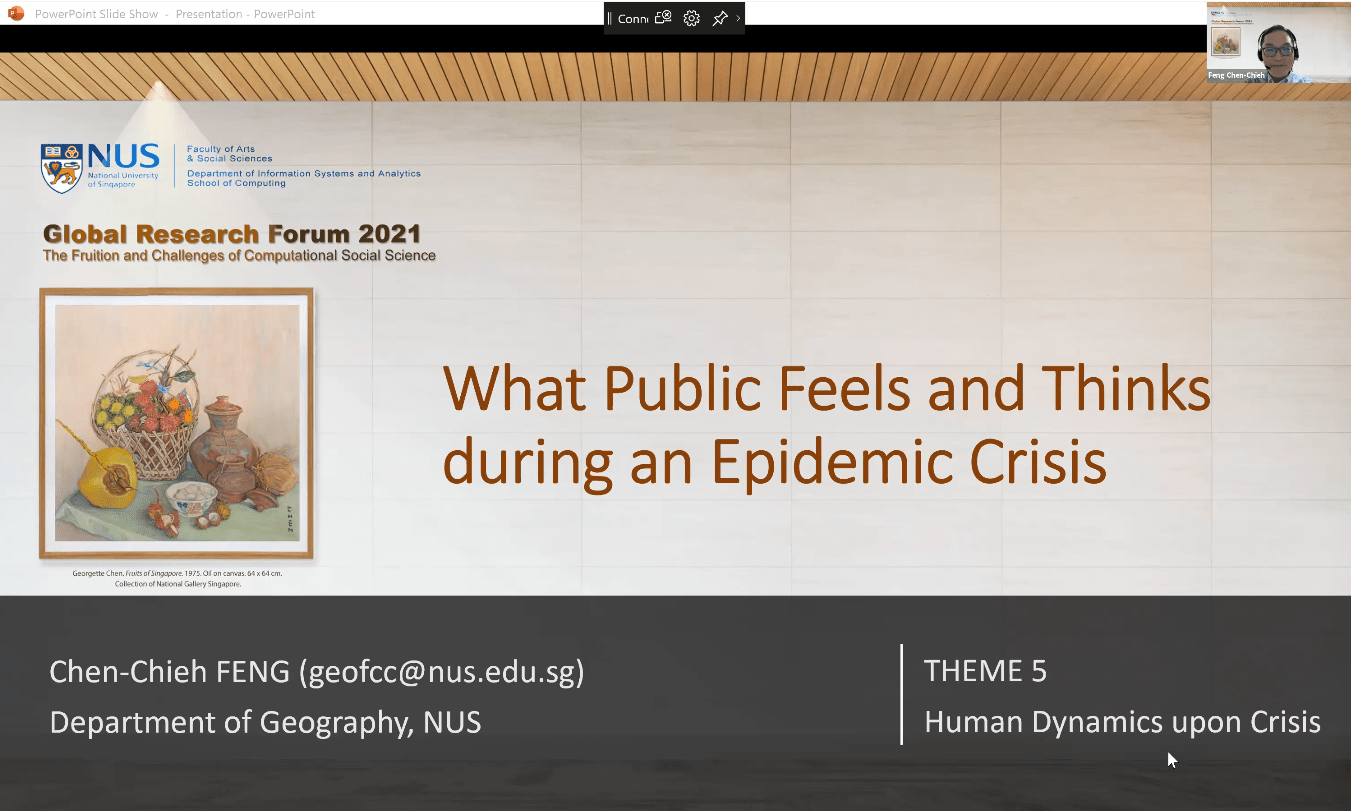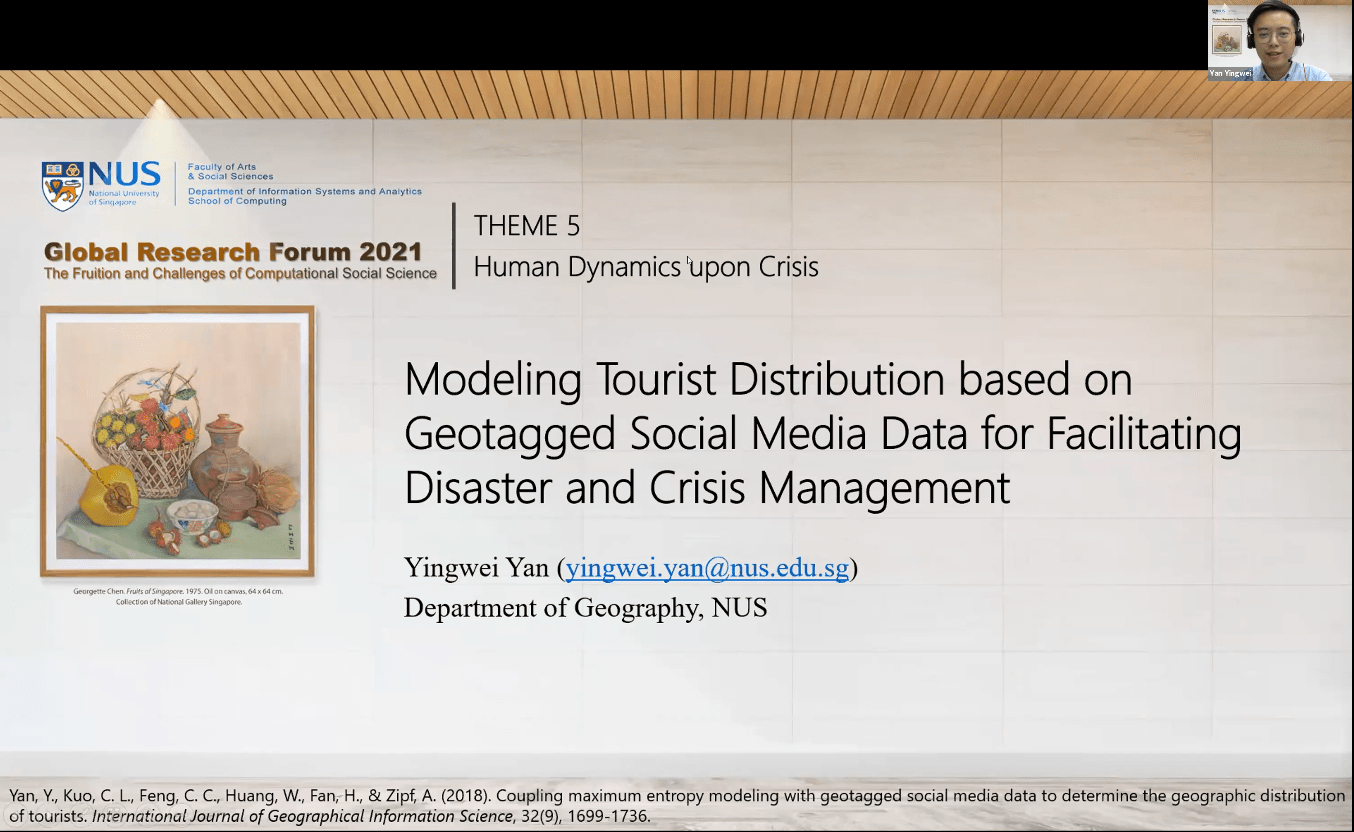The fifth theme of the Global Research Forum, ‘Human Dynamics Upon Crisis’, featured research by Associate Professor Feng Chen-Chieh (NUS Geography), Associate Professor Michelle See (NUS Psychology), and Dr Yan Yingwei (NUS Geography).
Assoc Prof Feng presented on ‘What the Public Feels and Thinks during an Epidemic Crisis’. His research is situated at the intersection of Geographic Information System (GIS) mapping and human dynamics, and examines spatiotemporal changes related to a crisis using user generated content. Assoc Prof Feng’s study looked at the effect of Singapore’s 2020 Circuit Breaker (CB), which lasted from April 7 to June 1, on residents’ emotions and their changes in sentiments.
During April 16 to May 31 2020, the researchers collected real-time tweets using COVID or coronavirus as keywords, authored by users in Singapore. Then they collected tweets from the same group of users (12,067 twitter accounts) from January 1 to May 31 2020, accumulating 6,244,585 tweets. They also collected baseline data from January 1 to May 31 2019 – tweets from the same accounts prior to the pandemic. The team focused on eight primary bipolar emotions in their analysis: joy versus sadness, anger versus fear, trust versus disgust, and surprise versus anticipation. They employed a Syuznet package of R for sentiment analysis, an ADF test for stationary analysis, and a hierarchical clustering of Scikit–learn for similarity analysis. The analyses revealed a slightly higher proportion of negative sentiments in 2020, and a rise of fear during mid-to-late March 2020 and late May 2020.
Assoc Prof Feng also mentioned that 105 languages were found to have been used in their sample, with the majority (84.51%) of the tweets in English. 4.04% of the tweets were in Malay, ranked second in the ten most tweeted languages, while Chinese was ranked seventh at 0.76% and Tamil was ranked eighth at 0.64%. The study compared the emotional valence and sentiment change of tweets across and within the different languages, and found that the emotional content of tweets significantly differed between languages. Assoc Prof Feng additionally pointed out that the tweets expressed a high level of trust and positive attitude facing the pandemic, specifically the 2020 CB, and that there was not a great variation in sentiment in the first five months of 2019 and 2020.
Assoc Prof See presented on ‘Attitude Polarization toward Immigrants: The Role of COVID-19 Misinformation Salience’. She discussed how her study, informed by Terror Management Theory (TMT), focuses on our worldview of global orientation in response to threats. The study examined how different levels of COVID-19 salience affected its participants’ willingness to interact with immigrants. Assoc Prof See explained that global orientation taps into our perceived ability to navigate intercultural contact and measures our levels of multicultural acquisition and ethnic protection. People with high levels of multicultural acquisition learn and speak foreign languages and read to increase their knowledge of foreign cultures, whereas people with high levels of ethnic protection stick to their own cultural norms wherever they go and make friends mostly with those who share their cultural origin; we possess greater global orientation if our multicultural acquisition is high and our ethnic protection is low.
The research team randomly assigned 210 Singaporeans to the COVID-19 salience conditions of present or absent (in other words, whether or not the pandemic was in effect), and assessed their level of global orientation. Then they assessed participants’ willingness to interact with mainland Chinese immigrants, and, as expected, found those with high global orientation more willing to interact. Interestingly, the presence of COVID-19 led to more willingness to interact among those with high global orientation, and less willingness to interact among those with low global orientation.
The study also explored participants’ cultural ideologies, specifically the following ideologies: 1) color blindness, where people are fundamentally the same and their individual characteristics make them unique; 2) multiculturalism, where unique characteristics of those with different origins are appreciated and a more harmonious society is developed when we learn how they resolve conflicts; 3) assimilation, where children from all countries should be taught mainstream national values and all Singapore residents should embrace the Singaporean dream of hard work and success; and 4) segregation, where people are naturally more comfortable living among others with the same national origin and conflict risk increases when people from different countries live close to one another. They found that, in the absence of a pandemic, multiculturalism was the most popular ideology with color blindness a close second; segregation was the least popular. In the presence of a pandemic, assimilation rose in popularity and color blindness lost some of its popularity. However, color blindness remained the second most popular ideology and there was no significant change in support for both multiculturalism and segregation.
The researchers additionally examined participants’ trust in media and found that the pandemic did not affect it; legacy news media outlets remained more trusted than friends and even more trusted than social media. Assoc Prof See pointed out that increasing people’s global orientation is a potential intervention or buffer against decreased acceptance of immigrants in times of crisis. She also noted that targeted efforts could be made to increase support for color blindness and decrease support for assimilation.
Dr Yan presented on ‘Modeling Tourist Distribution based on Geotagged Social Media Data for Facilitating Disaster and Crisis Management’. He explained that the research involved Volunteered Geographic Information (VGI), which, among available data sources, can be found in social media, particularly in OpenStreetMap. Dr Yan discussed his research on how Flickr data can be used to model tourist distribution. The study, set in San Diego, employed ‘crowd FDA’, or crowdsourcing for forensic data analysis and ‘niche modeling’, or maximum entropy modeling, to evaluate, map, and predict and project the model. 120,692 photos from 2010-2016 were collected and sorted into a smaller sample that excluded professional photos, photos missing user information, and photos likely not to have been taking for the purpose of sightseeing. The researchers also mitigated bias caused by power law distribution (also known as long tail distribution), where a minority of users contribute a majority of photos, by removing users who contributed more than 20 photos. The study also used environmental layers (with GIS) to analyze and map the photo data, then used it to test the tourist geographic distribution model.
The researchers found, using a jackknife test to examine geographic variable importance, that land use contributed heavily to the distribution of tourists in the area. Land parcels were also a large contributor, followed by distance to the nearest transit stops, and digital elevation models (bare earth); distance to the nearest major road was the smallest contributor. They were also able to identify the land use types most popular with tourists, with convention centers the most heavily photographed, followed by beaches. Furthermore, as Dr Yan explained, they could test scenarios such as the impact of tsunami inundation in the downtown area on the probability of tourist presence.
Watch the video from Theme 5: ‘Human Dynamics Upon Crisis’ here.
Stay tuned for more from the Global Research Forum!





You must be logged in to post a comment.